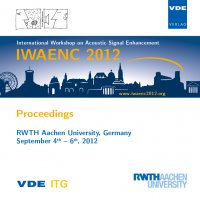A New Approach for Reduction of Supergaussian Noise Using Autoregressive Interpolation and Time-Frequency Masking
Konferenz: IWAENC 2012 - International Workshop on Acoustic Signal Enhancement
04.09.2012-06.09.2012 in Aachen, Germany
Tagungsband: IWAENC 2012
Seiten: 4Sprache: EnglischTyp: PDF
Persönliche VDE-Mitglieder erhalten auf diesen Artikel 10% Rabatt
Autoren:
Ruhland, Marco; Goetze, Stefan (Fraunhofer IDMT, Project group Hearing, Speech and Audio Technology, Oldenburg, Germany)
Brandt, Matthias; Doclo, Simon; Bitzer, Joerg (Fraunhofer IDMT, Project group Hearing, Speech and Audio Technology, Oldenburg, Germany )
Inhalt:
A new approach for noise reduction is presented. The method is capable of reducing noise of Gaussian, supergaussian and impulsive characteristics in degraded high-quality audio signals. The approach is based on classical autoregressive (AR) detection and interpolation, applied to the residual signal of a binary time-frequency (T-F) masking process. Analytic inspection allows for predicting the noise reduction level for white noise types and shows good accordance to simulation results. High reduction levels are achieved especially for supergaussian and impulsive disturbances having a higher sample kurtosis than Gaussian noise. The approach ensures high preservation of the underlying desired signal, satisfying the needs of high quality audio restoration. Furthermore, the approach is capable of reducing optical soundtrack noise of celluloid movie footage. Index Terms — Interpolation, Noise Reduction, Optical Soundtrack Noise, Supergaussian, Time-Frequency Masking


